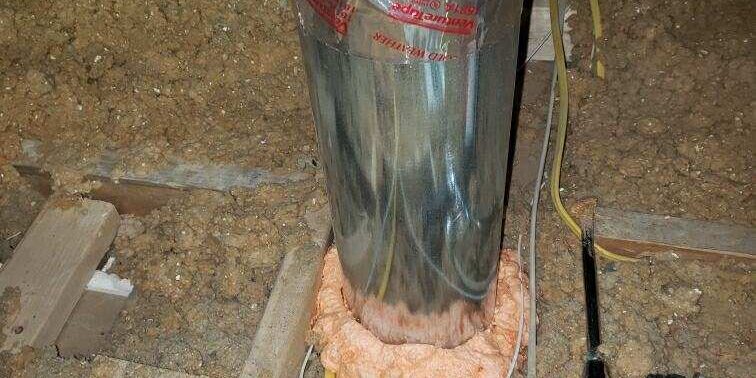Air leakage is one of the biggest threats to energy efficiency in your home. Even if your insulation is up to par, small gaps and cracks can allow conditioned air to escape—raising your energy bills and reducing comfort. At Insulation Pros of Colorado, we help homeowners in Loveland identify and seal these often-overlooked problem areas. In this blog, we’ll cover the top five air leakage points in your home, how to seal them, and why professional air sealing makes a real difference—especially in Colorado’s unpredictable climate.
1. Windows and Doors
Problem:
Windows and doors are common culprits for air leakage, especially in older homes. Gaps around the frame or between the sash and sill allow drafts to enter, leading to higher heating and cooling costs.
Solution:
Install weatherstripping along moving parts.
Use caulk or foam sealant around the edges of window and door frames.
Consider upgrading to energy-efficient models with low air infiltration ratings.
2. Attic Access Points
Problem:
Attic hatches, pull-down stairs, and even scuttle holes often lack proper sealing. Since warm air rises, these unsealed openings can cause major heat loss, especially in the winter.
Solution:
Add gasket-style weatherstripping to the attic door.
Insulate and seal the access panel.
Ensure attic insulation is properly installed around the access point.
3. Chimneys and Flues
Problem:
Spaces around chimneys and flue pipes are major sources of air leakage and can even contribute to moisture issues or pest intrusion if not sealed properly.
Solution:
Seal gaps with fire-resistant materials like sheet metal and furnace cement caulk.
Install a chimney balloon or flue sealer to block drafts when not in use.
Make sure the damper is tightly closed during off seasons.
4. Plumbing, Electrical & Duct Penetrations
Problem:
Any place where pipes, wires, or ductwork enter or exit your living spaces is a potential leak site. These gaps can let air, moisture, and even rodents into your walls or crawl space.
Solution:
Use spray foam insulation for larger gaps.
Apply acrylic-latex caulk for smaller cracks.
In crawl spaces or basements, pair sealing with vapor barrier installation for extra moisture protection.
5. Recessed Lights and Ductwork in the Ceiling
Problem:
Unsealed recessed lights and leaky ceiling ducts create a direct pathway for air to move between your home and the attic. This not only affects comfort but also encourages humidity issues and increases energy bills.
Solution:
Use airtight IC-rated light fixtures or add airtight baffles.
Seal around existing cans with foam or caulk (but follow safety codes).
Ensure duct connections are properly sealed with metal-backed tape or mastic sealant.
Why Air Sealing Matters in Colorado
Colorado homes, especially in areas like Loveland, face extreme temperature swings throughout the year. From freezing winters to hot, dry summers, these conditions make air sealing critical for:
- Reducing thermal bridging
- Lowering utility costs
- Improving indoor air quality
- Preventing mold, condensation, and energy loss
Professional air sealing complements other insulation services such as crawl space insulation, spray foam, and fiberglass insulation to complete your home’s building envelope.
Trust the Experts at Insulation Pros of Colorado
With more than a decade of hands-on experience in air sealing homes in Loveland, CO, our team knows how to find and fix hidden leakage points. We use building science-backed techniques like blower door testing and offer a variety of air sealing solutions tailored to your home’s structure.
Whether you need attic sealing, crawl space work, or a whole-home energy upgrade, Insulation Pros of Colorado is here to help you stay comfortable year-round.
Ready to lower your energy bills and increase your home’s efficiency?
Call Insulation Pros of Colorado today at (970) 980-6455 or schedule your estimate online!
FAQ: Air Sealing Your Home
1. How do I know if my home has air leaks?
Common signs include drafts, uneven temperatures, high energy bills, and visible gaps around windows, doors, or attic hatches. A blower door test from a professional can pinpoint exactly where air is escaping.
2. Is air sealing better than adding more insulation?
They work best together. Air sealing addresses the movement of air, while insulation slows heat transfer. Both are critical for a well-performing home.
3. What’s the best material to use for air sealing?
It depends on the location. Use caulk for small cracks, spray foam for larger gaps, and fire-rated materials around heat sources like chimneys or flues.
4. Does air sealing help with indoor air quality?
Yes. It reduces the entry of dust, allergens, and moisture, improving overall indoor air quality and reducing risk of mold and pollutants entering from crawl spaces or basements.
5. Can I DIY air sealing or should I hire a pro?
While some areas like caulking windows are DIY-friendly, sealing attics, crawl spaces, and ductwork is best left to professionals with experience and proper equipment.








